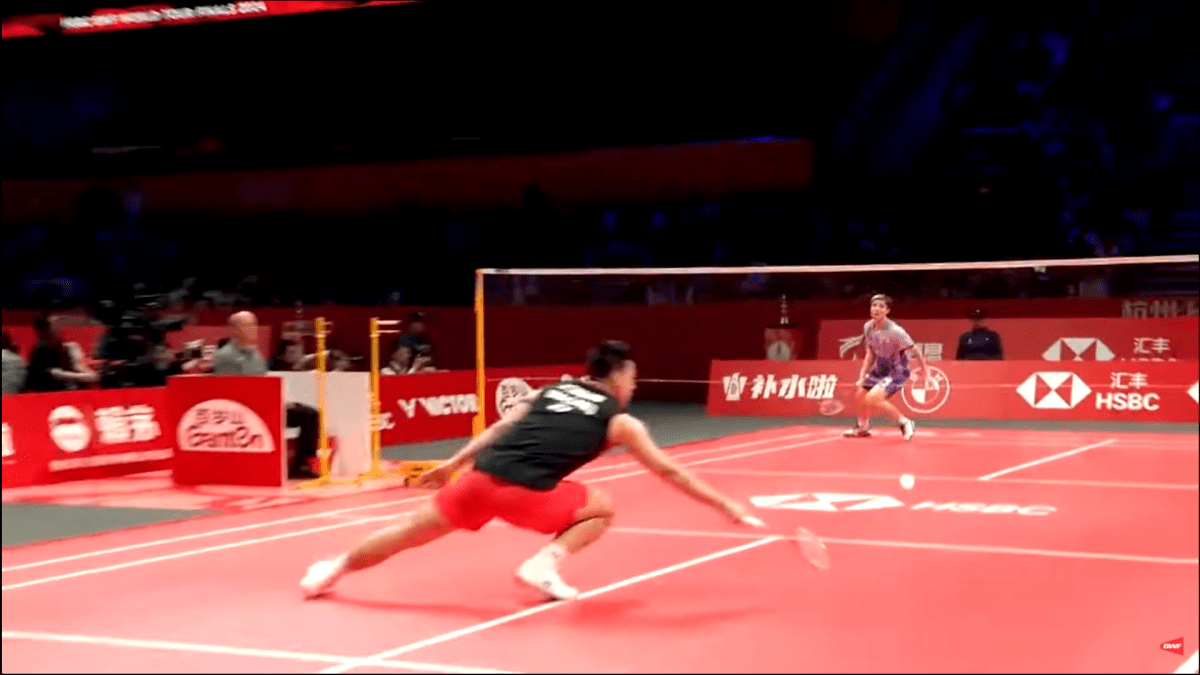Last entry, I was discussing about why we should lean forward after the smash. This entry, I am going to look at cases where player do not lean forward after the smash.
Clip 1
In the first clip above, we look at Lee Chong Wei versus Lin Dan again. Given how many times they faced each other, and the intensity of their rivalry, there are many examples from them. Last entry, I mentioned that Lee Chong Wei does not lean forward after his smash. He relies on his amazing speed in order to cover the court the way he does.
In this example, Lee Chong Wei executes his favourite smash, the cross court smash from his forehand side. He does the smash without a body turn. When the right conditions appear for him to do his smash, he does 2 rapid jumps, a small one followed by a big one and launches himself into the air. Lin Dan is able to block the smash, and despite Lee Chong Wei’s amazing speed, he reaches the shuttle when the shuttle is low. He is not able to get any advantage from his smash, and he is forced to lift the shuttle and wait for another opportunity to attack.
Clip 2

In the second clip above, Lee Chong Wei again executes his favourite smash from the same position. The conditions were right for him to hit the smash, and he chose to hit it cross court, as usual.
In this example, Lin Dan was ready for the smash, and he managed to block the smash right over the net. Even with Lee Chong Wei’s amazing speed, he could not reach the shuttle in time.
When hitting the cross court smash, there is always a risk that the return from the opponent is so good that we might not be able to reach the shuttle in time. Even the exceptionally fast Lee Chong Wei is not able to reach all the shots. It is therefore important to take every possible way to improve our chances.
Clip 3

In the third clip above, Shi Yuqi executes a cross court smash against Vitidsarn. This is the same shot which Lee Chong Wei uses so often. Shi Yuqi is no where near as fast as Lee Chong Wei. And when Vitidsarn is able to block the smash, Shi Yuqi is not able to reach it.
Shi Yuqi did the smash without a body turn. His landing was upright, and he was in balance, he did not lean forward. He had to turn, then run forward after the smash. Let’s look at it in slow motion.

Shi Yuqi’s turn to run is slightly slower than the movement to lean forward to run. And this fraction of a second slower cost him. He could not reach the shuttle in time to lift it.
Conclusion
The movement to leaning forward after the smash is extremely important as it saves the player a fraction of a second to move forward. It is the difference between getting the return after a smash to losing a point after the smash.
Most players opt to run forward after the smash instead of leaning forward. They trust their speed more. This is because to master the shift in balance to lean forward is extremely difficult.
In order to lean forward, the player must turn as he executes the smash. And when turning, the player needs to pull his legs behind him, while using his core muscles to pull his body forward. This is counter intuitive. Most players will go behind the shuttle and jump forward into the shuttle to hit the smash.
The turn to shift the upper body forward while pull the leg backward is not easy to do. And even a top player like Shi Yuqi does not do it cleanly. But if a player is able to do it consistently, his attacking play is going to be unbeatable. And we saw this in Lin Dan, Zhao Jianhua and Han Jian.
Strangely, to associate Han Jian with attacking play is odd as he is known for his long rallies. But, he switches to attack very quickly in those long rallies and always catches his opponents off guard. When he does attack, he almost always gets the point.
That’s it for this entry.
Until the next entry, eat well, get plenty of rest and keep the badminton going!
Berita Olahraga
News
Berita Terkini
Berita Terbaru
Berita Teknologi
Seputar Teknologi
Drama Korea
Resep Masakan
Pendidikan
Berita Terbaru
Berita Terbaru
Download Film
Gaming center adalah sebuah tempat atau fasilitas yang menyediakan berbagai perangkat dan layanan untuk bermain video game, baik di PC, konsol, maupun mesin arcade. Gaming center ini bisa dikunjungi oleh siapa saja yang ingin bermain game secara individu atau bersama teman-teman. Beberapa gaming center juga sering digunakan sebagai lokasi turnamen game atau esports.
